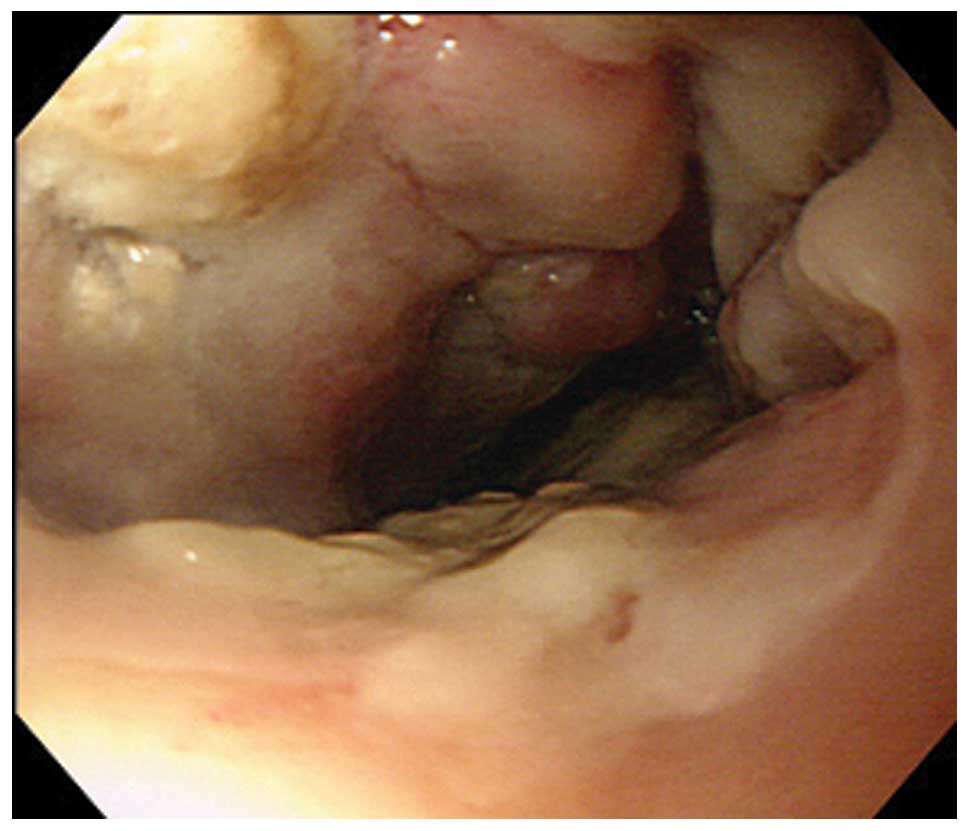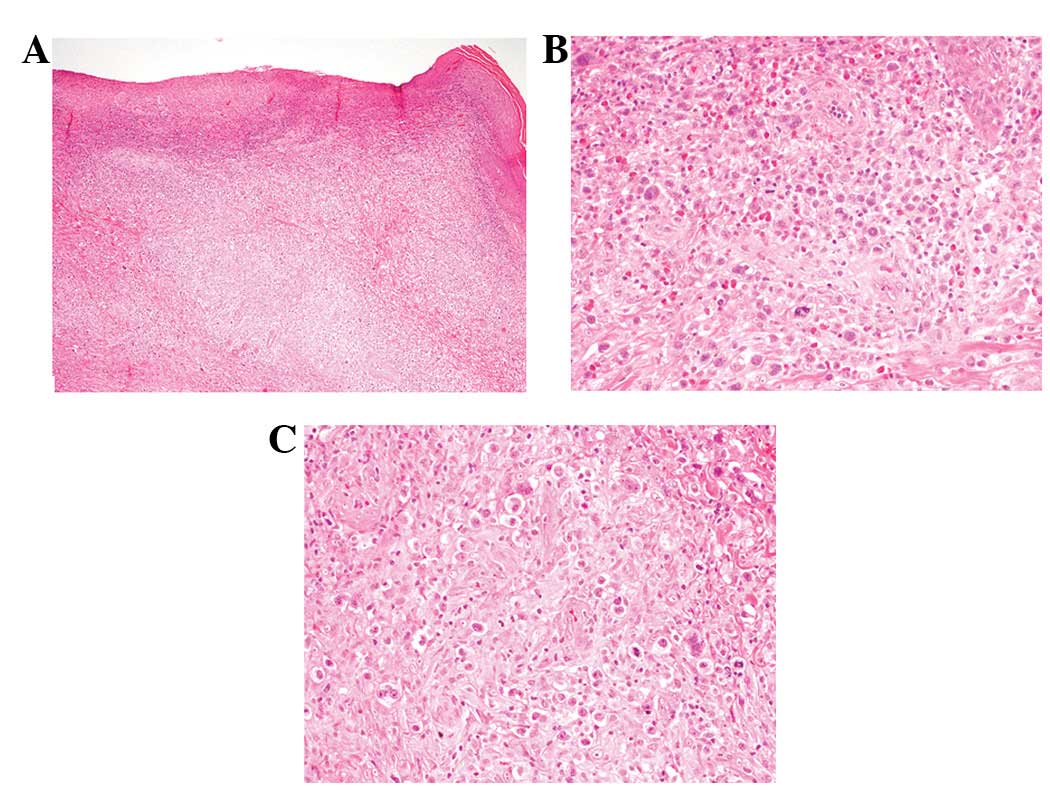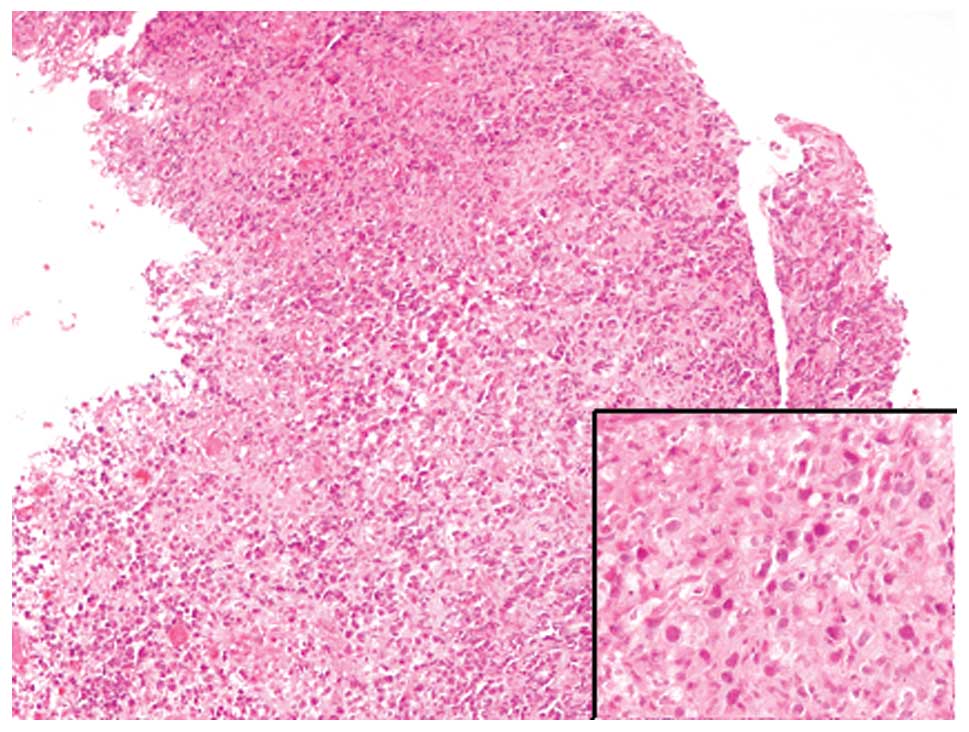CD8+ mycosis fungoides with esophageal involvement: A case report
- Authors:
- Published online on: October 16, 2012 https://doi.org/10.3892/ol.2012.973
- Pages: 73-75
Abstract
Introduction
Mycosis fungoides (MF) is the most common type of cutaneous T-cell lymphoma accounting for approximately 50% of all primary cutaneous lymphoma (1). MF is characterized clinically by an indolent course with slow progression, over years or occasionally decades, from patches to more infiltrated plaque and eventually tumor stages (1). MF is primarily limited to, but widely distributed on, the skin. However, during the advanced stages of the disease, MF has been identified in various extra-cutaneous regions, most commonly the lymph node, spleen, liver and lung (2). Esophageal involvement of MF has been previously identified, however cases are extremely rare (2–5).
MF is characterized histopathologically by infiltrates of small to medium-sized neoplastic T lymphocytes with cerebriform nuclei demonstrating epidermotropism. The typical phenotype of neoplastic lymphocytes is CD3+, CD4+ and CD8−(6). CD8+ MF has been identified, however, it is rare (6,7).
In the present study, we report the first documented case of CD8+ MF with esophageal involvement that was diagnosed endoscopically antemortem.
Patient and methods
Case report
A 70-year-old Japanese male with a 15-year history of MF presented with difficulty in swallowing. From the age of 56 years old, the patient reported observation of a gradually enlarging erythema on his left elbow. Four years following this, the patient was referred to Shiga University of Medical Science Hospital due to enlargement of the erythema across his entire body, accompanied by erosion in specific regions. Biopsy of the erythema led to diagnosis of MF with consideration of clinical findings.
Following this, the patient recieved radiation and psoralen ultraviolet A therapy and chemotherapy, including CEOP (cyclophosphamide, epirubicin, vincristine and prednisolone) and MEPP (mitoxantrone, etoposide, cisplatin and prednisolone). The erythema underwent periods of increased severity and remission and subsequently tumor formation was observed in specific regions. Biopsy of lesions with tumor formation was performed.
The patient reported pharyngalgia at 70 years old. The pharyngeal mucosa was eroded and a biopsy from the pharynx revealed involvement of MF. MEPP therapy was added to the patient’s therapy regimen. Two months later the patient presented with difficulty in swallowing and positron emission tomography revealed an accumulation in the esophagus and pharynx. Endoscopic examination identified a tumorous lesion with ulceration in all circumferences of the esophagus, 28–32 cm from the incisors (Fig. 1). Biopsy of this lesion was performed. Computed tomography demonstrated multiple tumorous lesions in the right lung, that were clinically suspected to be associated with MF. The patient received radiation and ESHAP (etoposide, solmedrol, high-dose AraC and cisplatin) therapy prior to succumbing to severe pneumonia and sepsis. This study was approved by the Ethics Committee of Shiga University of Medical Science and patient consent was obtained.
Methods
Formalin-fixed, paraffin-embedded tissue blocks of biopsy specimens from the skin and esophagus were cut into 3-μm thick sections, deparaffinized and rehydrated. Sections were stained with hematoxylin and eosin and used for immunostaining. Immunostaining was performed using an autostainer (Benchmark XT System, Ventana Medical System, Tucson, AZ, USA) according to the manufacturer’s instructions. The following primary antibodies were used: mouse monoclonal antibodies against βF1 (8A3, Thermo Scientific, Waltham, MA, USA), CD3 (PS1, Novocastra Laboratories, Ltd., Newcastle-upon-Tyne, UK), CD8 (1A5, Novocastra), CD20 (L26, Novocastra), CD56 (CD564, Novocastra), granzyme B (11F, Novocastra) and TIA-1 (TIA-1, GeneTex, TX, USA) and rabbit monoclonal antibody against CD4 (SP35, Ventana Medical System).
Results
Skin biopsy
The epidermis was identified as eroded (Fig. 2A). Small to medium-sized atypical lymphocytes had infiltrated into the entire dermis (Fig. 2A). Atypical lymphocytes had convoluted nuclei with a small to conspicuous nucleoli (Fig. 2B). Mitotic figures were scattered. Epidermotropism of the atypical lymphocytes was observed. Approximately 60% of the dermal infiltrate was composed of the above-mentioned small to medium-sized atypical lymphocytes and the rest were large-sized lymphocytes with a rich eosinophilic cytoplasm and large nuclei with conspicuous nucleoli. Multinucleated atypical lymphocytes were also identified (Fig. 2C).
Immunohistochemical analyses revealed that the atypical lymphocytes expressed βF1, CD3 and CD8 (Fig. 3A and B) and were negative for CD4 and CD56. CD30 was expressed in specific large-sized atypical lymphocytes, but not in small to medium-sized ones (Fig. 3C). In addition, the majority of the atypical lymphocytes were positive for granzyme B (Fig. 3D) and specific lymphocytes were TIA-1+.
Histopathological and immunohistochemical analyses resulted in diagnosis of MF with large cell transformation.
Esophageal biopsy
The esophageal mucosa was ulcerated. Atypical lymphocytes with convoluted nuclei were identified within the necrotic debris (Fig. 4). The immunohistochemical profiles of the atypical lymphocytes of the esophagus were identical to those of the skin specimen.
Discussion
In the present study, the first documented case of CD8+ MF with esophageal involvement that was endoscopically diagnosed antemortem was reported. Previously, Rappaport and Thomas analyzed 45 autopsied cases of MF and observed gross and/or microscopic evidence of MF in the extracutaneous organs in 32 cases (71%). The lymph node, lung, spleen, liver, kidney and thyroid gland were identified to be involved in MF in 24, 32, 19, 17, 14 and 13 cases, respectively. However, esophageal involvement was rare and only 4 cases were observed, among which no macroscopic tumor formation was revealed. In addition, laryngeal involvement of MF was identified in only 2 cases and revealed gross tumor formation. These analyses were performed postmortem and esophageal involvement is considered an incidental observation at autopsy (2). Kim et al were the first group to report a case of MF with esophageal involvement which was diagnosed antemortem (3). Following this, an additional case was reported by Redleaf et al, identifying MF involvement in the larynx, hypopharynx and cervical esophagus by antemortem endoscopic examination (4). However, the immunohistochemical phenotype of neoplastic T lymphocytes in the above-mentioned cases was not available. The present report describes the first documented case of CD8+ MF with esophageal involvement that was endoscopically diagnosed antemortem.
It is well known that a cytotoxic phenotype, as observed in the present case, does not reveal clinical and/or prognostic differences in MF. Massone et al previously classified early MF into 4 phenotypic groups: A (α/β+, CD4+, CD8−, TIA1−), B (α/β+, CD4−, CD8+, TIA1+), C (α/β− CD4−, CD8+/−, TIA1+) and D (α/β+, CD4−, CD8−, TIA1−) (6). Survival curves did not identify statistical differences among the groups (6), therefore, it is thought that CD8+ cytotoxic MF should not be considered a separate entity of MF (1). The present case study was classified into group B according to this classification (6). The lesions of the present patient were limited to the skin for more than 10 years, a typical clinical course of conventional MF. However, pharyngeal, esophageal and lung involvement was observed during the late stage.
Large cell transformation in MF is defined by the presence of more than 25% of large lymphoid cells in the dermal infiltrates (1). This phenomenon is detected in more than half of patients with tumor stage MF and is associated with a poor prognosis (8). CD30+ and CD30− large-sized lymphoid cells have been previously identified. However, in the present case, approximately 40% of the lesion was composed of large-sized atypical lymphocytes and specific cells were revealed as CD30+. Therefore, the definition of large cell transformation in this case was correct.
In conclusion, the present study describes the first documented case of CD8+ MF with esophageal involvement that was endoscopically diagnosed antemortem. MF is involved in the visceral organs, including the esophagus. Early detection of extracutaneous involvement of MF is important for accurate treatment and endoscopic examination is a useful tool for detection of MF involvement.
References
|
Ralfkiaer E, Cerroni L, Sander CA, Smoller BR and Willemze R: Mycosis fungoides. World Health Organization Classification of Tumours of Haematopoietic and Lymphoid Tissues. Swerdlow SH, Campo E, Harris NL, et al: 4th edition. IARC Press; Lyon: pp. 296–298. 2008 | |
|
Rappaport H and Thomas LB: Mycosis fungoides: the pathology of extracutaneous involvement. Cancer. 34:1198–1229. 1974. View Article : Google Scholar : PubMed/NCBI | |
|
Kim OD, Cantave I and Schlesinger PK: Esophageal involvement by cutaneous T-cell lymphoma, mycosis fungoides type: diagnosis by endoscopic biopsy. J Clin Gastroenterol. 12:178–182. 1990. View Article : Google Scholar : PubMed/NCBI | |
|
Redleaf MI, Moran WJ and Gruber B: Mycosis fungoides involving the cervical esophagus. Arch Otolaryngol Head Neck Surg. 119:690–693. 1993. View Article : Google Scholar : PubMed/NCBI | |
|
Dereure O and Guihou JJ: Mycosis fungoides with predominant periorficial and mucous involvement. Ann Dermatol Venereol. 132:877–880. 2005.PubMed/NCBI | |
|
Massone C, Crisman G, Kerl H and Cerroni L: The prognosis of early mycosis fungoides is not influenced by phenotype and T-cell clonality. Br J Dermatol. 159:881–886. 2008. View Article : Google Scholar : PubMed/NCBI | |
|
Ishida M, Hotta M, Takikita-Suzuki M, Kojima F and Okabe H: CD8-positive granulomatous mycosis fungoides: a case report with review of the literature. J Cutan Pathol. 37:1072–1076. 2010. View Article : Google Scholar : PubMed/NCBI | |
|
Cerroni L, Rieger E, Hödl S and Kerl H: Clinicopathologic and immunologic features associated with transformation of mycosis fungoides to large-cell lymphoma. Am J Surg Pathol. 16:543–552. 1992. View Article : Google Scholar : PubMed/NCBI |













